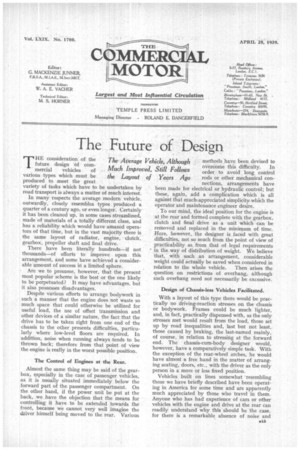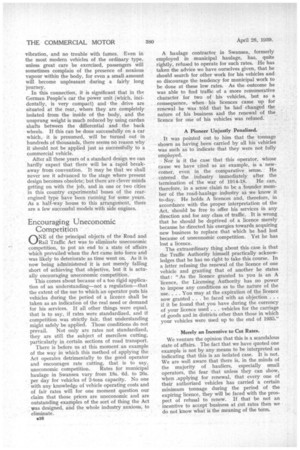The Future of Design
Page 21

Page 22

If you've noticed an error in this article please click here to report it so we can fix it.
THE consideration of the future design of corn various types which must be the Layout of produced to meet the great variety of tasks which have to be undertaken by road transport is always a matter of much interest.
In many respects the average modern vehicle, outwardly, closely resembles types produced a quarter of a century ago, or even longer. Certainly it has been cleaned up, in some cases streamlined, made of materials of a totally different class, and has a reliability which would have amazed operators of that time, but in the vast majority there is the same layout of radiator, engine, clutch-, gearbox, propeller shaft and final drive.
There have been literally hundreds—if not thousands—of efforts to improve upon this arrangement, and some have achieved a considerable amount of success in a limited sphere.
Are we to presume, however, that the present most popular scheme is the best or the one likely to be perpetuated? It may have advantages, but it also possesses disadvantages.
Despite various efforts to arrange bodywork in such a manner that the engine does not waste so much space that could otherwise be utilized for useful load, the use of offset transmission and other devices of a similar nature, the fact that the drive has to be taken right from one end of the chassis to the other presents difficulties, particularly where low-level floors are required. In addition, noise when running always tends to be thrown back; therefore from that point of view the engine is really in the worst possible position.
The Control of Engines at the Rear.
Almost the same thing may be said of the gearbox, especially in the case of passenger vehicles, as it is usually situated immediately below the forward part of the passenger compartment. On the other hand, if the power unit be put at the back, we have the objection that the means for controlling it have to be extended towards the front, because we cannot very well imagine the driver himself being moved to the rear. Various The Average Vehicle, Although methods have been devised to uf mercial vehicles of much Improved, Still Follows order to avoid long control Years Ago rods or other mechanical con nections, arrangements have been made for electrical or hydraulic control; but these, again, add a complication which is all against that much-appreciated simplicity which the operator and maintenance engineer desire.
To our mind, the ideal position for the engine is at the rear and formed complete with the gearbox, clutch and final drive as a unit which can be removed and replaced in the minimum a time. Here, however, the designer is faced with great difficulties, not so much from the point of view of practicability as from that of legal requirements in the way of distribution of weight. We believe that, with such an arrangement, considerable weight could actually be saved when considered in relation to the whole vehicle. Then arises the question on restrictions of overhang, although such overhang need not necessarily be excessive.
Design of Chassis-less Vehicles Facilitated.
With a layout of this type there would be practically no driving-reaction stresses on the chassis or bodywork. Frames could be much lighter, and, in fact, practically dispensed with, as the only stresses met would result from the load, those set up by road inequalities and, last but not least, those caused by braking, the last-named mainly, of course, in relation to stressing at the forward end. The chassis-cum-body designer would, however, have a comparatively simple task. With the exception of the rear-wheel arches, he would have almost a free hand in the matter of arranging seating, doors, etc., with the driver as the only person in a more or less fixed position.
Vehicles built on lines somewhat -resembling those we have briefly described have been operating in America for some time and are apparently much appreciated by those who travel in them. Anyone who has had experience of cars or other vehicles with the engine and drive at the rear can readily understand why this should be the case, for there is a remarkable absence of noise and vibration, and no trouble with fumes. Even in the most modern vehicles of the ordinary type, unless great care be exercised, passengers will sometimes complain of the presence of noxious vapour within the body, for even a small amount will become unpleasant during a fairly long journey.
In this connection, it is significant that in the German People's car the power unit (which, incidentally, is very compact) and the drive are situated at the rear, where they are completely isolated from the inside of the body, and the unsprung weight is much reduced by using cardan shafts between the differential and •the back wheels. If this can be done successfully on a car which, it is presumed, will be turned out in hundreds of thousands, there seems no reason why it should not be applied just as successfully to a commercial vehicle.
After all these years of a standard design we can hardly expect that there will be a rapid breakaway from convention. It may be that we shall never see it advanced to the stage where present design becomes obsolete; but there are clever minds getting on with the job, and in one or two cities in this country experimental buses of the rearengined type have been running for some years. As a half-way house to this arrangement, there are a few successful models with side engines.
Encouraging Uneconomic Competition
(-NNE of the principal objects of the Road and %h./Rail Traffic Act was to eliminate uneconomic competition, to put an end to a state of affairs which prevailed when the Act came into force and was likely to deteriorate as time went on. As it is now being administered it is not merely falling short of achieving that objective, but it is actually encouraging uneconomic competition.
This comes about because of a too rigid application of an understanding—not a regulation—that the extent of the use to which an operator puts his vehicles during the period of a licence shall be taken as an indication of the real need or demand for his services. If all other things were equal, that is to say, if rates were standardized, and if competition was strictly fair, that understanding might safely be applied. Those conditions do not prevail. Not only are rates not standardized, they are still the subject of merciless cutting, particularly in certain sections of road transport.
There is before us at this moment an example of the way in which this method of applying the Act operates detrimentally to the good operator and encourages rate cutting, that is to say, uneconomic competition. Rates for municipal haulage in Swansea vary from 18s. 6d. to 26s. per day for vehicles of 2-tons capacity. No one with any knowledge of vehicle operating costs and of fair rates will for one moment question our claim that those prices are uneconomic and are outstanding examples of the sort of thing the Act was designed, and the whole industry anxious, to eliminate. A haulage contractor in Swansea, formerly employed in municipal haulage, has, quite rightly, refused to operate for such rates. He has taken the advice we have ourselves given, that he should search for other work for his vehicles and so discourage the tendency for municipal work to be done at these low rates. As the outcome he was able to find traffic of a more remunerative character for two of his vehicles, but as a consequence, when his licences came up for renewal he was told that he had changed the nature of his business and the renewal of the licence for one of his vehicles was refused.
A Pioneer Unjustly Penalized.
It was pointed out to him that the tonnage shown as having been carried by all his vehicles was such as to indicate that they were not fully employed. Nor is it the case that this operator, whose cause we have cited as an example, is a newcomer, even in the comparative sense. He entered the industry immediately after the termination of the war of 1914-18. He can, therefore, in a sense claim to be a 'founder member of the road-haulage industry as we know it to-day. He holds A licences and, therefore, in accordance with the proper interpretation of the Act, should be free to offer his services in any direction and for any class of traffic. It is wrong that he should be deprived of a licence merely because he directed his energies towards acquiring new business to replace that which he had lost because of uneconomic competition. Yet he has lost a licence.
The extraordinary thing about this case is that the Traffic Authority himself practically acknowledges that he has no right to take this course. In a letter refusing the renewal of the licence of one vehicle and granting that of another he states that : "As the licence granted to you is an A licence, the Licensing Authority has no power to impose any conditions as to the nature of the use. . . . You may at the expiration of the licence now granted . . . be faced with an objection . . . if it be found that you have during the currency of your licence used . . . vehicles for the carriage of goods and in districts other than those in which your vehicles were used up to the end of 1935."
Merely an Incentive to Cut Rates.
We venture the opinion that this is a scandalous state of affairs. The fact that we have quoted one example is not by any means to be interpreted as indicating that this is an isolated case. It is not. We are well aware that there is, in the minds of the majority of hauliers, especially small operators, the fear that unless they can show, when ,applying for renewal, that every one of their authorized vehicles has carried a certain minimum tonnage during the period of the expiring licence, they will be faced with the prospect of refusal to renew. If that be not an incentive to accept business at cut rates then we do not know what is the meaning of the term.












































































